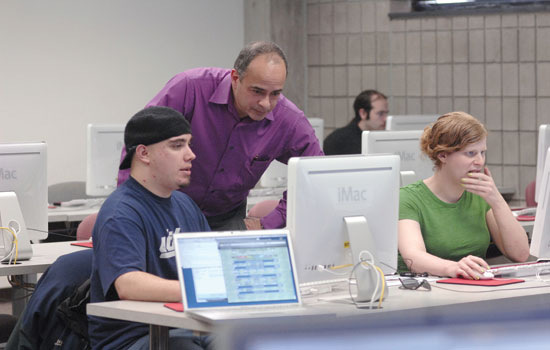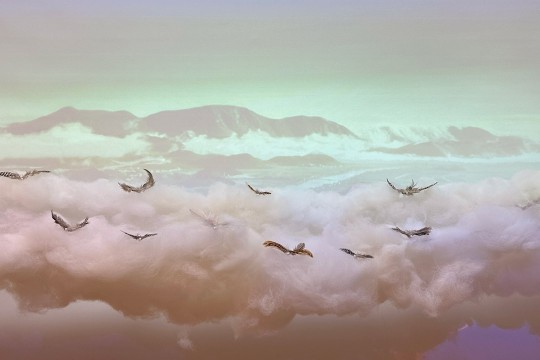Bioinformatics students explore scientific marvels—fruit flies
A. Sue Weisler
Professor Gary Skuse, center, helps undergraduates John Boutell, left, and Sophia Lafergola interpret fruit fly DNA in an upper-level bioinformatics class.
Students in the Advanced Applied Genomics class have an eye for detail. With painstaking effort, they stitch together sequences of genetic material and pull from it the portrait of a little known fruit fly.
The data is real; the work is hard and sometimes tedious. The intensity of the class requires a low teacher-to-student ratio. In this case, one professor and two teaching assistants for seven students. The upper-level bioinformatics class—which applies computer science to biological applications—meets for eight hours each week in a small computer lab.
“It’s a big commitment for everyone involved,” says Gary Skuse, director of bioinformatics in the College of Science, who offers the course once a year.
What makes Advanced Applied Genomics particularly challenging is precisely what draws many students to science: the thrill of discovery. Skuse and his teaching assistants Rhea Sanchez and Ashlee Benjamin work closely with the students to unravel and interpret the raw genetic data provided by the Genomics Education Partnership at Washington University, home to one of the few high-throughput genome sequencing centers in the world.
The Genomics Education Partnership, led by geneticist Sally Elgin at Washington University, is a consortium of scientists dedicated to improving genomic education. The partnership co-authored an article published in the Oct. 31 issue of Science that highlighted the model curriculum that transforms undergraduate classrooms into real-world laboratories.
The partnership gives the class DNA sequences and covers the cost of regenerating poor-quality data. The rest is up to the class, which must discover what is hidden in the sequences without a lot of guidance. Washington University trained Skuse’s assistants Sanchez and Benjamin, and paid them to assist the class.
Once the students have edited or “finished” the sequences—in this case, lining up 40,000 contiguous nucleotides, or molecules that make up DNA—they can begin annotating or extracting the genetic features. They note where genes begin and end and the pattern that makes one fly different from its cousins. The students tap all available resources—software gene checkers that act like spell-checking tools, comparisons with previously annotated flies and, most of all, each other.
“It’s really a group effort with a lot of discussions with the students,” says Skuse. “It’s very collaborative, very interdisciplinary. I think it’s safe to say we’re past the age where a scientist works as an individual. We acknowledge that we work better as groups than as individuals.”
At the end of the quarter, Skuse will submit the results back to Washington University along with the students’ pre- and post-course surveys assessing the effectiveness of the curriculum. Their work stands a chance of getting published, but more immediately contributes to the collective knowledge of the fruit fly.
“Our primary goal is education. We’re all learning how to teach more effectively using this real-life scenario,” Skuse says.















